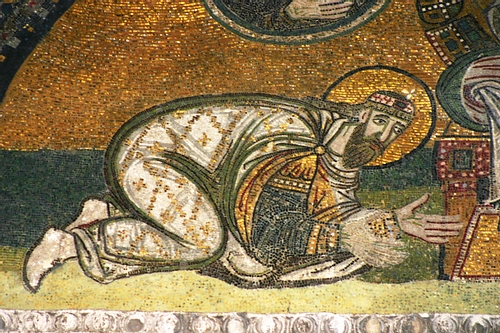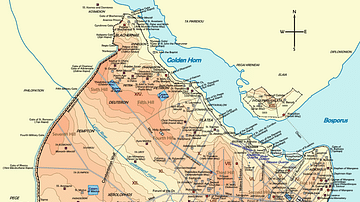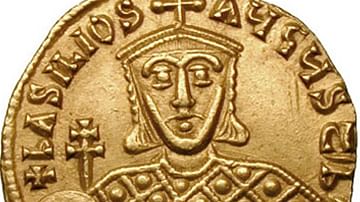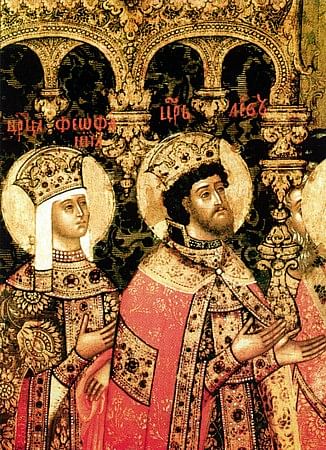
Leo VI was emperor of the Byzantine empire from 886-912 CE. He was the second emperor of the Macedonian dynasty and is sometimes known as “Leo the Wise” in reference to his prolific literary output which ranged from orations to law codes. Leo's military campaigns abroad were not at all successful, and the empire witnessed defeats to the Bulgars in the Balkans and the Arabs in Sicily and the Aegean. At home, it was a different story, and the emperor's reign was a rare one of stability, peace, and prosperity for his people.
Parentage & Succession
Leo, although officially the son and heir of Basil I (r. 867-886 CE) was widely rumoured to actually have been the son of Michael III (r. 842-867 CE). This was because Basil's wife and Leo's mother was Eudokia Ingerina, who had formerly been the mistress of Michael. Basil had had another son - his eldest, favourite, and first-choice heir, Constantine - but he had died prematurely in 879 CE of unknown causes. Basil's relationship with his second-choice heir was a troubled one. Leo, forced to marry a young girl of his father's choosing - the pious Theophano - had acquired himself a mistress named Zoe Zautsina who, naturally, his father disapproved of. Basil tried, unsuccessfully, to break the relationship by banishing the girl and making his son a virtual prisoner in a wing of the royal palace. Beaten, imprisoned, and threatened with blinding, it is perhaps no wonder that Leo might have borne a grudge which would one day prove fatal for his father.
Basil I died in 886 CE. The cause, according to official records, was a hunting accident. The tale was a tall one involving the 74-year-old emperor being dragged an improbable distance through the woods by a stag and then rescued by a group led by Zoe's father. It seems much more likely that Leo arranged for his father to be helped off his throne. It is, perhaps, significant that one of the first acts of the new 19-year-old emperor, now Leo VI, was to exhume Michael III's body from his nondescript grave and entomb him with full imperial honours in a fine marble sarcophagus in the Church of the Holy Apostles in Constantinople.
Personal Life & Tetragamy
Leo's personal life was certainly eventful. When his first wife Theophano died in 895 CE aged just 20, he finally got to marry his Armenian mistress Zoe Zautsina, doing so in 898 CE. Theophano, for her piety and good works, would later be made a saint. Leo promoted Zoe's father Stylianos Zautsina to be his personal advisor, inventing the new title of basileopator for him. In another act of looking after the family first, the emperor made his weak and short-lived younger brother Stephen the Bishop (Patriarch) of Constantinople, incredibly then only 15 years of age. Unfortunately, Zoe died one year into her marriage and Leo was still without an heir. A third marriage was required, but the Church traditionally did not condone more than two marriages. Nevertheless, Leo went ahead and married again, this time to Eudokia Vaiana in 900 CE, but it was not to be third time lucky, and she died in childbirth along with her baby in 901 CE. There was still no heir in the palace.
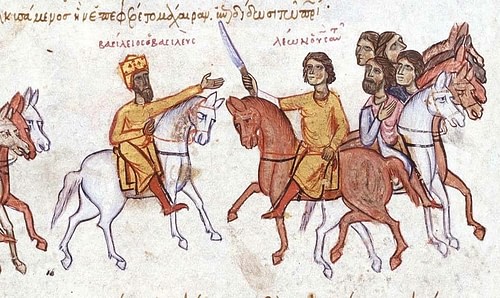
Following the death of Eudokia, Leo's fourth marriage in 906 CE to his mistress Zoe Karvounopsina was one step too far for the Church. First, the pair had already had a child out of wedlock the previous year, the future emperor Constantine VII. This was probably Leo's attempt to make sure the marriage would be worthwhile as it was absolutely his last chance of having a son. Second, the Patriarch of Constantinople, Nicholas I Mystikos, was dead set against yet another marriage for the emperor, and so erupted the crisis known as the tetragamy. Leo was not to be dictated to by a bishop, though, and so married his second Zoe anyway and then dismissed and exiled Nicholas in 907 CE, appointing as his replacement the more supportive Euthymios. The pair of bishops each had their own powerful support groups, and so the Byzantine church was split over the issue. Leo would later reverse his decision and recall Nicholas, then dismiss Euthymios, in 912 CE, but full reconciliation in the Church would not be achieved until 917 CE.
Leo further muddied the ecclesiastical waters by acquiring the endorsement of the Pope for his fourth marriage, something Sergius III was willing to provide because, following a longstanding rivalry, it made him look like he had superiority over the Church at Constantinople. Leo had already managed, with a few false promises to the Patriarch, to get his illegitimate son baptised on 6 January 906 CE, and now he finally received the Church's blessing for his marriage to Zoe. The empire had, at last, the legitimate heir so necessary to avoid a civil war of succession on Leo's death.
Military Campaigns
Leo's reign was a decidedly uninspired one when it came to warfare with losses left, right, and centre. The Byzantine Empire suffered major defeats against Symeon, Tsar of the Bulgars (r. 893-927 CE), in the Balkans. Symeon was unimpressed with the Byzantine stranglehold on trade, the imposition of new import duties on Bulgarian goods, and the moving of the official state imports port from Constantinople to the less accessible Thessaloniki. Symeon invaded Byzantine territory in 894 CE but was pushed back by Leo's allies the Magyars, who attacked from the rear. A withdrawal of Byzantine troops thinking all was secured was followed by Symeon immediately forming a new alliance with the Turkish Pechenegs and reattacking Thrace. Symeon's accumulation of victories eventually forced Constantinople to pay a significant tribute and reagree a more favourable trade deal for the Bulgars.
There were some successes against the Arab Caliphate in Armenia and Syria, but closer to home there were more setbacks. Abydos and Thessaloniki fell to the Arab admiral (although actually a Greek who had converted to Islam) Leo of Tripoli in 904 CE. Thessaloniki, the second most important city in the empire and its fortifications having recently been badly damaged by an earthquake, was sacked and, in a week of carnage, half its population was either killed or enslaved. A revenge of sorts was achieved when the Byzantines sacked the Arab-held city of Tarsus in 905 CE. There had already been defeats to the Arabs in Sicily and, with the loss of Taormina on 1 August 902 CE, so went any vestige of Byzantine control on the island. Constantinople was attacked in 907 CE by Oleg, Prince of Kiev (r. 879 - c. 912 CE), although a treaty in 911 CE established trade relations between the two states. Also in 911 CE, yet another attempt by the Byzantines to take Arab-held Crete failed. Finally, a Byzantine fleet was destroyed off the coast of Chios by the Arabs in 912 CE, commanded by that man Leo of Tripoli again. Leo might have managed to create a peaceful and prosperous empire within its borders, but outside of them, his campaigns were disastrous.
Legal Reforms & Literature
Leo continued the legal reforms of his predecessor, probably completing Basil's work on revamping the old Justinian law code. These reforms, which became known collectively as the Basilika (“Imperial Laws”), filled 60 volumes but were encapsulated in two handbooks, the Epanagogue (886 CE) and Procheiron (907 CE). The main points of interest were that the laws were written in Greek, not Latin, and they were organised by subject for ease of reference by judges and lawyers.
Not limiting himself to legal matters, Leo was a prolific writer of all sorts, earning him the epithet sophotatos or "the Wise". He wrote homilies, poems, hymns, orations, theological treatises and, despite his army's poor performances (or perhaps because of them), even a military manual, the Taktika, in which he proposed the advantages of guerrilla tactics and attacking an enemy force when they were weighed down with booty. Another important work credited to Leo was the c. 911 CE Book of the Eparch which outlined rules for trade and commerce, and specified regulations for the 19 guilds, five of which were involved in the manufacture of silk. Finally, to the delight of modern historians, Leo commissioned Philotheos, the Eparch (Governor) of Constantinople, to compile his Kletorologion, a comprehensive list of Byzantine court titles, offices, and protocols. Leo was not limited to the written form either, and he delivered many elaborate sermons in various churches across his capital.
Death & Successor
When Leo died on 11 May 912 CE, his only male heir was Constantine VII who had, according to custom, already be crowned co-emperor by his father in 908 CE. However, because of his young age, Constantine's uncle Alexander acted as his regent, and he proved reluctant to ever let go of the reigns of power. After a string of other regents, which included his mother, Constantine finally took the throne in his own right in 945 CE, better late than never.
